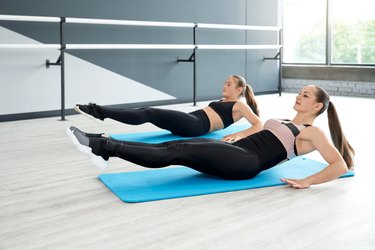
If you've been focused on strengthening your core, chances are you're familiar with hollow body holds. This exercise is a fairly advanced abdominal move that targets your rectus abdominis, external obliques and transverse abdominis, as well as your back and spine.
"It's important to have a strong core for the general integrity and health of our backs," says Andres Padilla, CPT, personal trainer, board-certified exercise physiologist and owner of AP3 Personal Training. "Oftentimes when you hear that someone [has injured] their back, it's because they have a weak core, and when your core is weak, you're more susceptible to getting injured."
Video of the Day
But as with many advanced strength exercises, they can be seriously hard to do! So, if you're having a hard time nailing the hollow body hold, we share a few common reasons why — plus what you can do to help.
First, How to Do a Hollow Body Hold With Proper Form
- Lie down on your back on the floor or on an exercise mat and press your lower back down into the ground.
- Squeeze your navel down toward the floor to activate your abdominal muscles. Make sure your legs are glued together as you gently raise them up off the ground.
- Float and extend both arms overhead and gently raise your head and shoulders off the floor, keeping your arms by the side of your face.
- Keeping your lower back flush against the floor, hold this position. Think about pulling your bellybutton into the ground.
Why You May Struggle With Hollow Body Holds
One of the main reasons you may struggle to do a hollow body hold is because you're lacking enough core strength to begin with, according to Padilla, which can make it easy to compromise or arch your back. (We've got a few exercises to help you build core strength below!)
Other reasons include if you're dealing with a lower back or hip flexor injury, or if you have weak neck muscles, which can make it hard to keep your head up. Additionally, if you have vertigo, you may find you get dizzy if you're not doing the move correctly, Padilla says.
If you're finding you're having a hard time with hollow body holds or suspect you're doing them incorrectly, Padilla recommends chatting with a certified fitness trainer for an assessment. They can pinpoint if your head is too far forward, you lower back isn't pressed into the floor or if you're not breathing properly during the exercise.
Finally, not everyone is necessarily suited to do this exercise. If you have a history of lower back pain or any kind of spine issue (like nerve damage or sciatica), Padilla generally recommends avoiding this move. But the good news is Padilla doesn't consider hollow body holds to be the pinnacle of core strength, so a trainer can help you come up with alternative exercises you can do that'll work your core and not bother your back.
Exercises to Build Up to a Hollow Body Hold
If you don't yet have the muscle strength to be able to do a hollow body hold, there are other exercises you can do to work up to it. Padilla recommends the following three moves.
1. Coffee Table Crunch
Hollow body holds can put a lot of strain on your lower back. But because your thighs are vertical during this exercise, it's easier to engage your core muscles without having to compromise your lower back, according to Padilla.
- Lie on your back on a mat with your knees in tabletop position bent at a 90-degree angle.
- Exhale, contract your abs and lift your head and shoulder blades off the ground. Your neck can curl slightly, but it shouldn't strain toward your chest.
- Inhale as you lower back down so that your head is hovering just off the ground and repeat.
2. Boat Balance
Because this move is similar to a hollow body hold — you're just sitting on your glutes instead — it's a great way to see if you're ready for hollow body holds. "If you can't get into a boat balance, it will be very tough to get into a hollow body hold, which is why this is highly recommended to start," Padilla says.
- Sit tall on your mat with your knees bent and feet flat on the floor.
- Extend your arms out in front of you and raise your feet until your lower legs are parallel to the mat.
- Lean your torso back to about a 45-degree angle.
- Draw the crown of your head up and lengthen through the spine; do not let your back round. Focus on maintaining a strong core.
- Flutter your arms up and down for more of a challenge.
3. Opposite X
This exercise does a great job at engaging all the muscles around the core to get you ready for hollow body holds, according to Padilla.
- Start lying on the ground with your legs extended and held together, arms above your head, elbows along your ears.
- Raise your torso, right arm and left leg off the ground. Touch your right arm to your left foot.
- Lower your torso, right and arm left leg back down to the starting position.
- Raise your torso, left arm and right leg off the ground. Touch your left arm to your right foot.
- Lower your torso, right and arm left leg back down to the starting position.
- Repeat, continuing to alternate arms and legs.